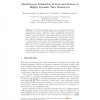Free Online Productivity Tools
i2Speak
i2Symbol
i2OCR
iTex2Img
iWeb2Print
iWeb2Shot
i2Type
iPdf2Split
iPdf2Merge
i2Bopomofo
i2Arabic
i2Style
i2Image
i2PDF
iLatex2Rtf
Sci2ools
DAGM
2009
Springer
2009
Springer
Simultaneous Estimation of Pose and Motion at Highly Dynamic Turn Maneuvers
Abstract. The (Extended) Kalman filter has been established as a standard method for object tracking. While a constraining motion model stabilizes the tracking results given noisy measurements, it limits the ability to follow an object in non-modeled maneuvers. In the context of a stereo-vision based vehicle tracking approach, we propose and compare three different strategies to automatically adapt the dynamics of the filter to the dynamics of the object. These strategies include an IMM-based multi-filter setup, an extension of the motion model considering higher order terms, as well as the adaptive parametrization of the filter variances using an independent maximum likelihood estimator. For evaluation, various recorded real world trajectories and simulated maneuvers, including skidding, are used. The experimental results show significant improvements in the simultaneous estimation of pose and motion.
| Added | 26 May 2010 |
| Updated | 26 May 2010 |
| Type | Conference |
| Year | 2009 |
| Where | DAGM |
| Authors | Alexander Barth, Jan Siegemund, Uwe Franke, Wolfgang Förstner |
Comments (0)

